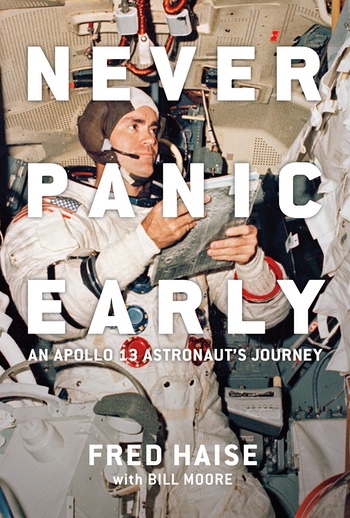Review: Never Panic Earlyby Jeff Foust
|
| After his first flight in a training aircraft, “I walked away from that plane knowing that I was no longer going to be a journalist.” |
He hadn’t, until now. Never Panic Early is a straightforward autobiography about a man who will be forever linked with Apollo 13, but whose career in the military, at NASA, and in industry goes far beyond that single spaceflight.
Unlike many other early astronauts who had a passion for aviation from an early age, Haise’s interest in flying came much later. Through high school and junior college his interest was primarily in journalism, but when he failed to secure a scholarship to attend the University of Missouri to study journalism there, he decided to join the military, enlisting the Naval Aviation Cadet Program. After his first flight in a training aircraft, “I walked away from that plane knowing that I was no longer going to be a journalist.”
After a brief career in the Marines, he completed a college degree and became a pilot for NASA, first at Lewis Research Center in Cleveland and later at Edwards Air Force Base, the latter allowing him to go to test pilot school, run at the time by Chuck Yeager. In 1966, he became a NASA astronaut, initially supporting work on the Lunar Module at Grumman before being assigned to the backup crews for both Apollo 8 and Apollo 11.
His chapter on Apollo 13 is similar to previous accounts of the mission, with just a few additional details. He explained that the urinary tract infection he got came from a request from Mission Control not to vent urine overboard because it was affecting tracking of the spacecraft, which meant they stored urine in whatever containers were available, including backup bags from the Gemini program. “Lazy me made the choice to leave a Gemini bag attached to my body, for over a day, to make the urine-transfer process easier,” he writes, but that led bacteria to build up and cause the infection.
Haise returned to a backup role on Apollo 16, an assignment that originally put him on a path to command Apollo 19. That mission, though, was cancelled before Apollo 16’s launch 50 years ago this month. Instead, Haise got involved in the shuttle program, first as part of NASA teams evaluating contractor proposals and, eventually, flying the first orbiter, Enterprise, on a series of glide tests at Edwards. He was assigned to fly on the STS-3 shuttle mission, which originally was intended to go to the Skylab space station to attach a booster to raise its orbit. However, delays in the shuttle meant that Skylab reentered nearly two years before the first shuttle launch. Haise said at that point, rather than wait for another chance to go to space, “I set my sights to move into executive management,” leaving NASA in 1979 to work for Grumman until his retirement in the mid-1990s.
While the book is an autobiography, much of it focuses on his professional life rather than his personal one. The end of his first marriage—a casualty, like others from that era, from the race to the Moon—and the start of his second get only brief mentions in the book. By contrast, his corporate adventures later in his career at Grumman get much more attention.
The book’s title comes from a phrase that came up many times as a pilot and astronaut: when a problem appears, don’t panic but instead calmly work to solve it. Haise successfully did that through his career, be it overcoming a problem with an aircraft in flight or a spacecraft heading to the Moon.
Note: we are using a new commenting system, which may require you to create a new account.
